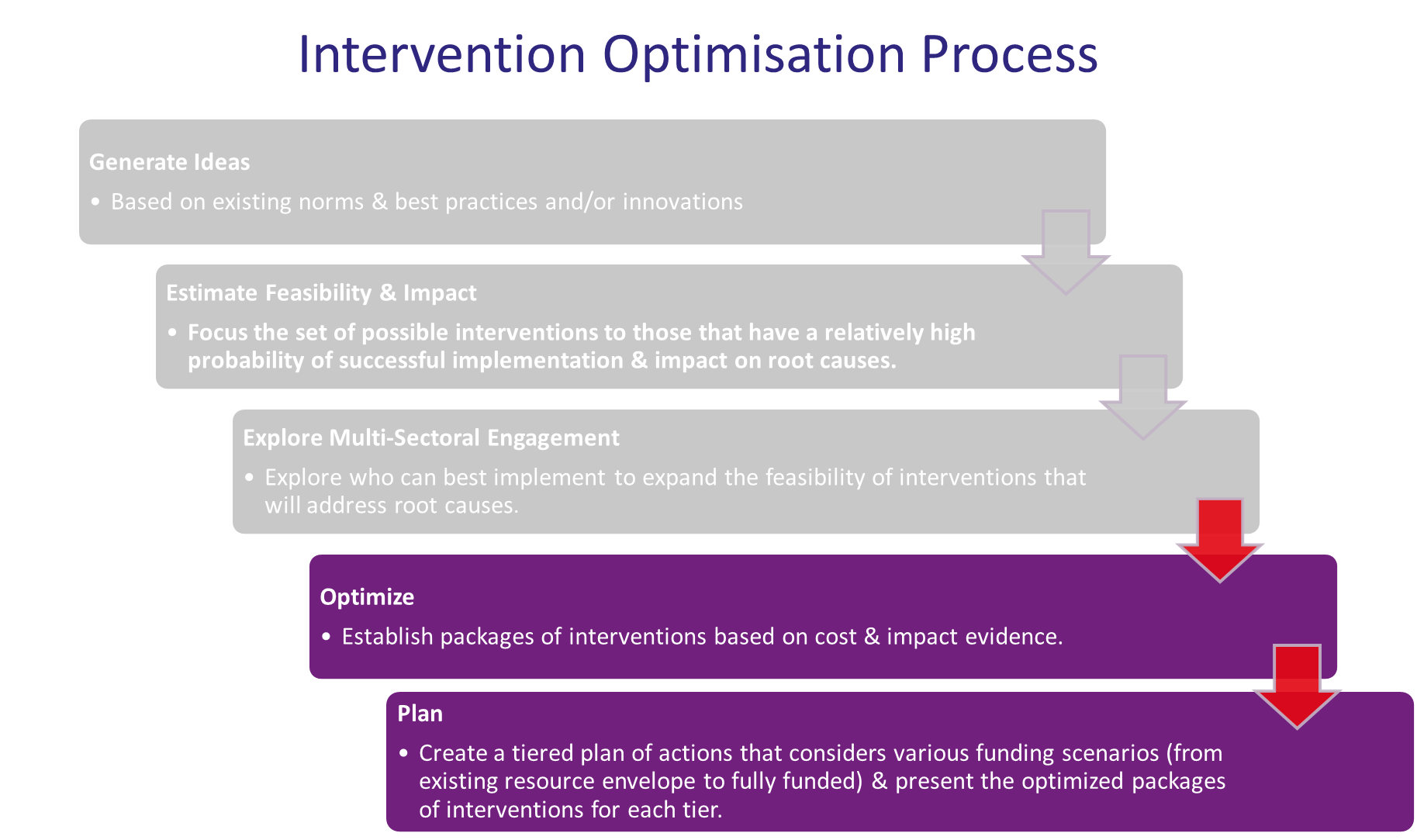Intervention prioritisation/ optimisation is the final step before documentation and operational planning can take place. At this stage programmes need to carefully balance ambition with resource limitations. As the results of this exercise are the foundation of investment cases (i.e., providing the rationale and justification for domestic and external funding requests), the outputs of this stage are usually documented in form of scenarios.
Steps 5 and 6 of the consultative workshop can be further broken down into the following 5 sub-steps:

The previous section, intervention identification, addresses the first 3 steps: (1) Generating ideas, (2) Estimating feasibility & impact, and (3) Exploring multi-sectoral engagement. The Intervention prioritisation, “Optimisation” step examines what programmes can realistically achieve within the resource envelope they have available. This step is quite tricky, as it usually involves dealing with a substantial level of uncertainty requiring several assumptions – based on experience (local and global), modelling, and expert opinion. It also requires a careful balancing act of different demands and expectations from communities & affected populations, from within the system (e.g., political commitments to geographic areas or causes, competing priorities and demands on resources from different programmes, and global pressures and expectations from the international community and donors).
Some country programmes separate the optimisation step from the consultative workshop altogether, to support the decision-making process through intervention costing, impact and cost effectiveness modelling exercises as these activities are somewhat time consuming and there is usually not enough time to include them in the workshop. However, there are some important preparatory steps to inform costing and modelling, which are best addressed during the workshop.
It is important to note that decision makers usually talk about prioritisation of interventions – however, for effective and efficient TB programming it is virtually impossible to prioritise interventions (i.e., chose one over the other) without compromising the outcome and impact. We prefer therefore to focus on optimisation as the careful balancing of demands, interventions and resources to achieve the maximum impact within a limited resource envelope.
Intervention Optimisation Process
- Step 1: Review interventions identified during the previous session against prioritised problems and their root causes – ensure they align. If areas remain not addressed, flag and if possible rectify.
- Step 2: Map and rank identified interventions by importance (i.e., impact on the ability of the programme to reach essential targets), urgency, and relationships/ dependencies (i.e., some interventions are relying on certain conditions or for other interventions to happen first to be possible/successful)
- Step 3: Describe the interventions you are doing today and need to continue to ensure the programme maintains the current level of success (e.g. “sustain the gains”). – don’t forget to note the changes/ adjustments needed to improve these interventions while doing so.
- Step 4: Map the newly identified and expanded/ modified current interventions against the remaining programmatic gaps you are trying to address during the new implementation period.
- Step 5: Define indicators for each intervention (i.e., measures which allow you to gauge that the interventions are working as expected).
- Draft intervention packages were indicated
- Map interventions/ intervention packages, and where indicated tailored approaches based on geographic areas, key populations, service provider types and levels, etc. as appropriate.
- Discuss and define scenarios for investment cases – levels of ambition for different funding levels
At this point agree upon and document:
- The evidence and assumptions underlying each intervention (this will feed into the model design and calibration).
- Decision making criteria (these might be different for different stakeholders and need to be aligned and agreed).
- Indicators to be used to measure and verify success.
- Any other relevant context specific considerations which need to be included (e.g., seasonal access barriers to certain areas, migration pattern, etc.).
- Priority interventions and scenarios should be developed in preparation for the modelling exercises, and subnational validation and planning.
At the end, the rapporteurs collate the results and present them to the plenary session for further consultation, clarification, input, recommendations, and consensus.
Last Update: Tuesday, January 3, 2023